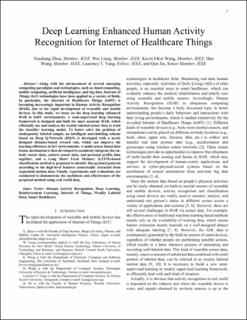| dc.contributor.author | Zhou, Xiaokang | |
| dc.contributor.author | Liang, Wei | |
| dc.contributor.author | Wang, Kevin I-Kai | |
| dc.contributor.author | Wang, Hao | |
| dc.contributor.author | Yang, Laurence T. | |
| dc.contributor.author | Jin, Qun | |
| dc.date.accessioned | 2020-04-07T08:02:31Z | |
| dc.date.available | 2020-04-07T08:02:31Z | |
| dc.date.created | 2020-04-05T13:11:27Z | |
| dc.date.issued | 2020 | |
| dc.identifier.citation | IEEE Internet of Things Journal. 2020, . | en_US |
| dc.identifier.issn | 2327-4662 | |
| dc.identifier.uri | https://hdl.handle.net/11250/2650589 | |
| dc.description.abstract | Along with the advancement of several emerging computing paradigms and technologies, such as cloud computing, mobile computing, artificial intelligence, and big data, Internet of Things (IoT) technologies have been applied in a variety of fields. In particular, the Internet of Healthcare Things (IoHT) is becoming increasingly important in Human Activity Recognition (HAR), due to the rapid development of wearable and mobile devices. In this study, we focus on the deep learning enhanced HAR in IoHT environments. A semi-supervised deep learning framework is designed and built for more accurate HAR, which efficiently use and analyze the weakly labeled sensor data to train the classifier learning model. To better solve the problem of inadequately labeled sample, an intelligent auto-labeling scheme based on Deep Q-Network (DQN) is developed with a newly designed distance-based reward rule, which can improve the learning efficiency in IoT environments. A multi-sensor based data fusion mechanism is then developed to seamlessly integrate the on-body sensor data, context sensor data, and personal profile data together, and a Long Short Term Memory (LSTM)-based classification method is proposed to identify fine-grained patterns according to the high-level features contextually extracted from sequential motion data. Finally, experiments and evaluations are conducted to demonstrate the usefulness and effectiveness of the proposed method using real world data. | en_US |
| dc.language.iso | eng | en_US |
| dc.publisher | Institute of Electrical and Electronics Engineers (IEEE) | en_US |
| dc.title | Deep Learning Enhanced Human Activity Recognition for Internet of Healthcare Things | en_US |
| dc.type | Peer reviewed | en_US |
| dc.type | Journal article | en_US |
| dc.description.version | acceptedVersion | en_US |
| dc.source.pagenumber | 10 | en_US |
| dc.source.journal | IEEE Internet of Things Journal | en_US |
| dc.identifier.doi | 10.1109/JIOT.2020.2985082 | |
| dc.identifier.cristin | 1805321 | |
| dc.description.localcode | © 2019 IEEE. Personal use of this material is permitted. Permission from IEEE must be obtained for all other uses, in any current or future media, including reprinting/republishing this material for advertising or promotional purposes, creating new collective works, for resale or redistribution to servers or lists, or reuse of any copyrighted component of this work in other works. | en_US |
| cristin.ispublished | false | |
| cristin.fulltext | postprint | |
| cristin.qualitycode | 1 | |
